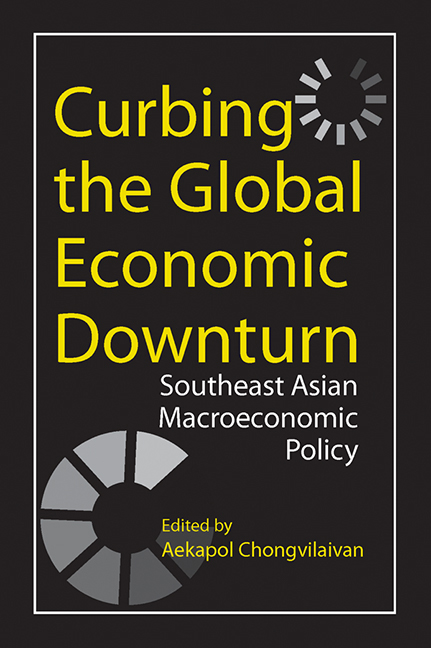Book contents
- Frontmatter
- Contents
- Acknowledgements
- Introduction
- List of Contributors
- PART I Economic Fluctuations: Macroeconomic Effects and Policy Responses
- 1 Macroeconomic Impacts of a Financial Crisis
- 2 Capital Inflow Reversals, Current Account Adjustments, and Macroeconomic Performance
- 3 Supply-Side Causes of Macroeconomic Fluctuations in a Small Open Economy
- 4 Effectiveness of Fiscal Stimuli
- 5 Public Debt Sustainability and Its Macroeconomic Impacts
- PART II Economic Co-operation in Southeast Asia
- Index
5 - Public Debt Sustainability and Its Macroeconomic Impacts
from PART I - Economic Fluctuations: Macroeconomic Effects and Policy Responses
Published online by Cambridge University Press: 21 October 2015
- Frontmatter
- Contents
- Acknowledgements
- Introduction
- List of Contributors
- PART I Economic Fluctuations: Macroeconomic Effects and Policy Responses
- 1 Macroeconomic Impacts of a Financial Crisis
- 2 Capital Inflow Reversals, Current Account Adjustments, and Macroeconomic Performance
- 3 Supply-Side Causes of Macroeconomic Fluctuations in a Small Open Economy
- 4 Effectiveness of Fiscal Stimuli
- 5 Public Debt Sustainability and Its Macroeconomic Impacts
- PART II Economic Co-operation in Southeast Asia
- Index
Summary
INTRODUCTION
Capital flight from the emerging economies of East Asia in 1997–98 precipitated the most notable geo-financial crisis of the second half of the twentieth century with lasting international economic and political effects. Thailand, Malaysia, the Philippines, and Indonesia (the ASEAN-4) in particular were severely distressed by near simultaneous exchange rate and asset price collapses that devastated banking and financial sectors, slashed real investment and induced recessions (see, for instance, Chang and Velasco 1999, Eichengreen 2002, Furman and Stiglitz 1998, Glick, Moreno and Spiegel 2001, Goldstein 1998, Makin 1999 and Radelet and Sachs 1998). South Korea, an advanced economy, also suffered directly although quickly recovered, while Hong Kong, Taiwan, and Singapore were punished indirectly through associated trade shocks that dampened or negated previously strong growth rates.
Numerous factors triggered the international capital flow reversals that caused financial crisis in the ASEAN-4. These included poor corporate governance, overvalued exchange rates and excessive foreign borrowing by domestic banks for unproductive projects. However, fiscal balances had generally been sound and inflation rates moderate. In contrast, overall budget balances measured as a proportion of GDP have deteriorated markedly in the ASEAN-4 economies since the crisis, turning pre-crisis fiscal surpluses to deficits that remain high by the standards of developed economies (Makin 2005). Most notably, Malaysia and the Philippines have posted persistent deficits between 4 to 6 per cent of GDP since 2000 (see Figure 1).
The consolidated public debt (inclusive of the debt of all tiers of government and non-financial public enterprises) to income ratios of the ASEAN-4 economies have accordingly risen well above pre-crisis levels (see Figure 2) to historically high levels across the region. They are generally well in excess of the average public debt to income ratio of advanced economies of around 25 per cent (IMF 2003).
Public debt grew strongly because the ASEAN-4 governments actively deployed fiscal policy as a post-crisis counter-cyclical measure to boost domestic demand in the context of a global economic slowdown. Accelerated domestic financial liberalization also facilitated issuance of public debt instruments in home markets over this time.
- Type
- Chapter
- Information
- Curbing the Global Economic DownturnSoutheast Asian Macroeconomic Policy, pp. 77 - 96Publisher: ISEAS–Yusof Ishak InstitutePrint publication year: 2010



